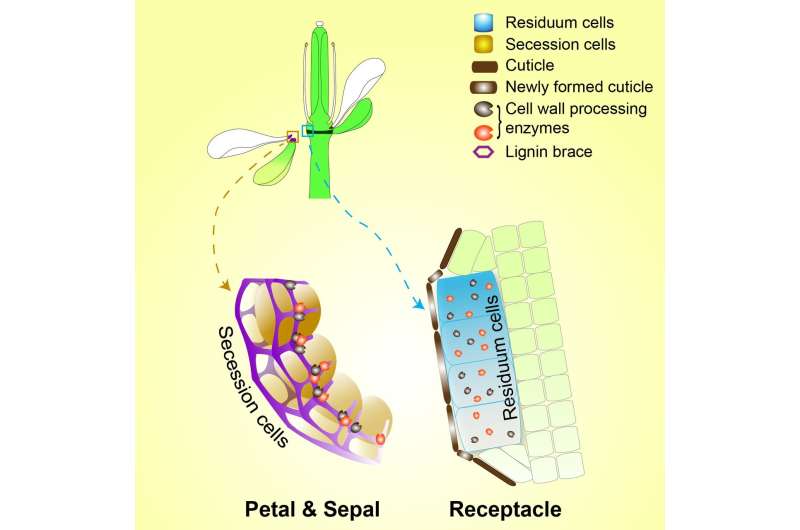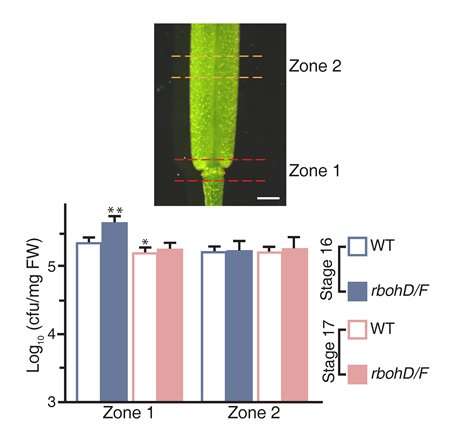Plants get a brace to precisely shed flowers and leaves

In the spring, pink cherry blossom petals are borne by the wind. Each of the falling petals leaves behind a little open cut on the plant, which might be prone to infection. The same happens when plants shed leaves, fruits and seeds. Biologists at DGIST and IBS have just reported in Cell how plants regulate the detachment process and protect themselves. As shedding is closely associated with a plants' life cycle, this is a topic of substantial interest to improve crop and fruit production.
In order for leaves, flowers and fruits to drop, specific proteins known as cell wall processing enzymes need to act precisely to degrade the cell wall, facilitating cell-to-cell detachment. Similar to a plant wound, the opening must be quickly resealed to avoid bacterial infection, but the researchers found that in contrast to a wound, plants use a different mechanism to seal the opening.
The detachment spot (abscission zone) was found to consist of two neighboring cell types: residuum cells (RECs) remaining on the plant and secession cells (SECs). "The separation must be precise and minimal, as the process transiently increases vulnerability to environmental peril," explains June M. Kwak, leading author of the study.
DGIST and IBS researchers used the classic plant model Arabidopsis thaliana to investigate how plants overcome the physical constraint of cell walls and accomplish organ abscission. The two cell types in the abscission zone display different cellular activities and architectures. In particular, SECs form two to three layers of lignin with a honeycomb structure. On the detachment area, lignin acts as a molecular brace that may hold individual SECs together when they shed from the plant. In addition, it might limit cell wall processing enzymes to a confined area, allowing precision abscission.
"Because of the light and rigid property of the honeycomb architecture, it is perhaps unsurprising that we find plant cells have evolved such a structure to accomplish a potentially dangerous cellular process with great accuracy," explains Kwak.
Immediately after SECs are borne away by wind, RECs accumulate a thin cell wall that is vulnerable to infections and external harm. To protect the newly formed cell surface, RECs shield themselves with a protective coating made of cutin, which is responsible for the surface protection against pathogens. This indicates that non-epidermal RECs change identity turning into epidermal cells. This is particularly interesting as the specification of epidermal cell identity was thought to be restricted to the embryonic stage.
The formation of this cutin layer is distinct from the mechanism of plant wound healing. The latter provides a protecting barrier made of cork rather than cutin. How the two processes are related is still mysterious.

More information: Yuree Lee, Taek Han Yoon, Jiyoun Lee, So Yeon Jeon, Jae Ho Lee, Mi Kyoung Lee, Huize Chen, Ju Yun, Se Yun Oh, Xiaohong Wen, Hui Kyung Cho, Hyunggon Mang, and June M. Kwak. A Lignin Molecular Brace Controls Precision Processing of Cell Walls Critical for Surface Integrity in Arabidopsis. Cell (2018). DOI: doi.org/10.1016/j.cell.2018.03.060
Journal information: Cell
Provided by Institute for Basic Science





















